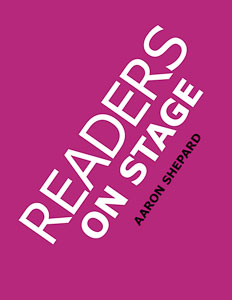|
Mumble, mumble,
Stop and stumble.
Pages turn
and readers fumble.
|
If this sounds like a description of your reader’s theater efforts, try giving your readers the following tips.
Preparing
First, here are instructions your readers can follow—individually or in a group—to prepare their scripts and get familiar with their parts.
Highlight your speeches in your copy of the script. Mark only words you will speak—not the identifying role tags or the stage directions. (Yellow non-fluorescent marker works best.)
Underline the words that tell about anything you’ll need to act out—words in either the stage directions or other readers’ speeches. If you’re given extra stage directions later, write them in the margin in pencil.
Read through your part silently. If there are words you don’t understand or aren’t sure how to pronounce, look them up in a dictionary. If there are words you must remember to stress, underline them. If there are places you’ll need to pause between sentences, mark them with a couple of slashes ( // ). For instance, a narrator must sometimes pause to help the audience know there’s a change of scene or time.
Read through your part out loud. If you’re a character, think about how that character would sound. Should you try a funny voice? How would the character feel about what’s happening in the story? Can you speak as if you were feeling that?
Stand up and read through the script again. If you’re a character, try out faces and movements. Would your character stand or move in a special way? Can you do that? If possible, try all this in front of a mirror.
Even before you give your readers their scripts, you can help them by reading to them the script or its source story. Effective modeling will give them a head start against any difficulties. You might also want to discuss the difference between characters and narrators. (“In the story, character parts are inside the quotation marks, and narrator parts are outside.”)
Rehearsing
Here are pointers your readers should remember in both rehearsal and performance.
Hold your script at a steady height, but make sure it doesn’t hide your face. If there’s anyone you can’t see in the front row of the audience, your script is too high.
While you speak, try to look up often, not just at your script. When you do look down at it, keep your head up and move just your eyes.
S‑l‑o‑w d‑o‑w‑n. Say each syl‑la‑ble clear‑ly.
TALK LOUD! You have to be heard by the little old deaf lady in the back row.
Speak with feeling. Audiences love a ham!
Stand and sit straight. Keep your hands and feet still, if they’re not doing anything useful!
Face the audience as much as you can, whether you’re moving or standing still. If you’re rehearsing without an audience, pretend it’s there anyway and remember where it is.
Narrators, you’re important even when the audience isn’t looking at you. You control the story! Be sure to give the characters enough time to do what they must. And remember that you’re talking to the audience, not yourself.
Characters, you give the story its life! Remember to be your character even when you’re not speaking, and be sure to react to the other characters.
To help your readers get full vocal power, have them check their breathing. To do this, they should place their hands on their stomachs and inhale. If they’re really filling their lungs, their hands will be pushed out. (The diaphragm muscle gives the lungs more room by pushing down on the stomach, making it expand forward.) If their hands move in, it means they’re filling only the top parts of their lungs.
Tongue twisters and other vocal exercises can help your readers speak more clearly. You might even warm them up with such exercises before your rehearsals and performances.
To help your readers hold themselves straight, ask them to imagine a string tied to their chest, pulling up.
Performing
Before an actual performance, discuss with your readers the “what‑ifs.”
If the audience laughs, stop speaking till they can hear you again.
If someone talks in the audience, don’t pay attention.
If someone walks into the room, don’t look.
If you make a mistake, pretend it was right.
If you drop something, try to leave it at least till the audience is looking somewhere else.
If a reader forgets to read, see if you can read their part instead, or make something up, or maybe just skip over it. But don’t whisper or signal to the reader!
If a reader falls on their bottom, pretend they didn’t.
Finally, a couple of reminders for the director: Have fun, and tell your readers what they’re doing well!
